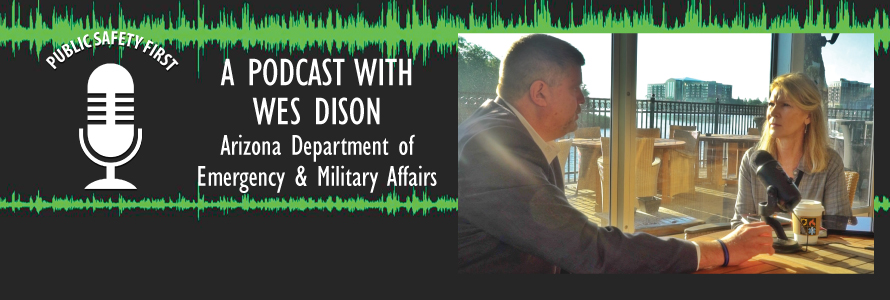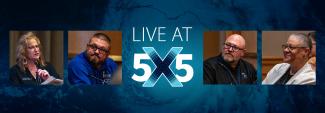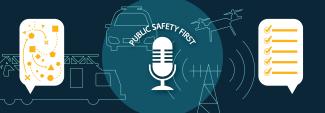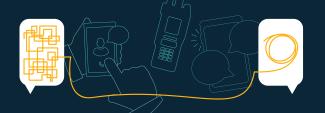Summary
In this episode of Public Safety First, guest host, Lesia Dickson, FirstNet’s Director of Field Operations for the North-central region sits down with Arizona DEMA’s Wes Dison at the 2018 NEMA Forum in Savannah, Georgia to discuss Arizona’s experience with FirstNet during high-profile events such as Senator McCain’s funeral in August.
Guest
Lesia Dickson
FirstNet Authority Director of Field Operations, North-Central Region
Wes Dison
Director of Communications, Arizona Department of Emergency and Military Affairs
Transcript
Preview
Narrator: You're listening to Public Safety First – a podcast to help you learn about the First Responder Network Authority and how you can be part of the future of public safety technology.
Lesia Dickson: Good morning, we’re here at the National Emergency Management Association Annual Conference in Savannah, Georgia and I’m visiting today with Wes Dison from the Arizona Department of Emergency Management and Military Affairs. Welcome Wes and thank you for doing this with us this morning.
Wes Dison: Good Morning!
Lesia Dickson: Wes, can you give us your title and what you do at DEMA?
Wes Dison: Well, my current official assignment is Director of Communications and Assistant Director for Operations in the, in the EOC during activations, and I'm the Operations Chief and Situation Unit Leader.
Narrator: You're listening to Public Safety First – a podcast to help you learn about the First Responder Network Authority and how you can be part of the future of public safety technology.
Lesia Dickson: Good morning, we’re here at the National Emergency Management Association Annual Conference in Savannah, Georgia and I’m visiting today with Wes Dison from the Arizona Department of Emergency Management and Military Affairs. Welcome Wes and thank you for doing this with us this morning.
Wes Dison: Good Morning!
Lesia Dickson: Wes, can you give us your title and what you do at DEMA?
Wes Dison: Well, my current official assignment is Director of Communications and Assistant Director for Operations in the, in the EOC during activations, and I'm the Operations Chief and Situation Unit Leader.
Lesia Dickson: Great. So this conference is one that I know you've prioritized every year. What do you get out of the NEMA conference? Why do you come?
Wes Dison: Well, I think there's two big benefits. First of all, the collaboration. You know, you get to meet and talk to people. Emergency Management is now a nationwide effort. It's not a state-by-state. There's so much sharing and supporting of staff and resources across the nation, so seeing people that you've talked to on the phone or had email exchanges with, things like that, building those relationships. And then really getting kind of a national perspective on what everybody is challenged with. I think sometimes we think our challenges are unique, you know our grant problems are unique to us, or our technology capabilities and what you find out is it's really everybody having the same struggles.
Lesia Dickson: Absolutely, and you mentioned technology. So I know that you are over that for Arizona at the state level, what are some of the trends that you see relative to technology and both what you're doing and what you see in the future?
Wes Dison: Well, I think the biggest thing that we have in Arizona is a pretty common term, ‘situational awareness’. How do we gain that, and how do we gain it quickly? In this age of technology, everything is available so quickly and the public wants it, our political leaders want it, our decision-makers want it.
So, ‘How do we acquire that situational awareness as quickly and as accurately as we can?’ is a big push. So the availability of streaming video, or chat capabilities, or tools like Web EOC things like that, and how to maximize those tools with each other is really a big push for us.
Lesia Dickson: Well, I can see why. From a FirstNet standpoint, we're about mobile communications and mobile broadband. How do you see mobile broadband fitting into this new world of emergency management?
Wes Dison: Well, I don't know that it fits in. I think it more dictates because really today is not about being tied to a desk or a computer anymore, it's about mobile. One of the tests that we have is informing our governor, Governor Ducey. He's a very active person, he's out and about all the time. He carries a tablet with him, so being able to provide him again that live-time or as close to live-time as possible in many cases live-time situational awareness information, is, it's required any more.
Lesia Dickson: Absolutely. Well, you mentioned something that I bring up quite often at FirstNet which is EOC’s are not just in buildings and bunkers anymore they're out there, mobile. So what are some of the technologies that you are using in Arizona today relative to mobile?
Wes Dison: Probably, we have two principle situational awareness tools that we're using: Web EOC, which is pretty common to a lot of emergency management agencies across the country, now. We are heavily invested in Web EOC. We currently have an enterprise application for that – that includes all of our counties, all of our tribes, and it's quite successful. We’re into going to re-write now, and a rebuild, and refresh of the program if you will, and that's our primary crisis emergency management information-sharing tool. Although we use it every single day 24 hours a day seven days a week. So, that's our primary tool, and then because that's simply a narrative device, we have in the last year and a half, heavily invested in ArcGIS and that provides the visual connects to the narrative. In this age, the governor doesn't like to read a bunch of narrative. He likes to look at a map, or look at an illustration, or look at something else that gives him kind of an instant snapshot of maybe that press interview that's coming, something like that. So, we are heavily invested in ArcGIS. We like, again many agencies across the state, are using a dashboard developed through ArcGIS that provides – we’ll speak about the governor in specific – provides him a statewide view of everything that's going on within the state enterprise. Whether it's flooding, it's modeled off to the ESF structure, and so he can look at any one point in time and see what's going on with fires, or flooding, or traffic, or a hazmat situation somewhere. And so, those are the two primary tools that we're using. So, we have a narrative, and we have a visualization tool.
Lesia Dickson: Right, well a picture’s worth a thousand words or a million for sure.
Wes Dison: Yes ma’am.
Lesia Dickson: Some of the things that you and I have talked about over the years: predictive analytics, artificial intelligence. Where do you see us going with those things in the emergency management discipline?
Wes Dison: Well, I you know I will confess to not knowing a lot about that yet. I still think it's very emerging. We are actually currently engaged in some effort to explore that in Arizona. I think the key behind it though is: whatever that looks like, whatever the technology is, the demand from the public and from local leaders is no longer a reactionary posture, but more of a predictive posture; trying to get some idea of what this thing; a special event, a fire, a flood, what it’s going to look like, where it's going to go, there's historical information. Floods pretty much usually go in the same place, right? So if you have prior flood history, how can you access that, maybe visualize it, and make decisions ahead of time so that you can block the roadways, or close the underpass, or whatever it might be in order to avoid a problem rather than to respond to it.
Lesia Dickson: That's excellent, you know, in my past experience, it seems like we were really excited to get a data stream and do something with it, but now it seems like the challenge is to get multiple data streams and somehow put them together and make decisions with them. How do you see that kind of playing out in the future to bring these datasets together?
Wes Dison: Well I think that's actually a key challenge, because there are so many data streams available now, pretty much every day I learned was something new in Arizona that I didn't even know we had. Our Department of Public Safety is installing haboob sensors, dust storm sensors – that's all live-time information. I think what we’re challenged with now is how to garner all that information through all those different streams and very quickly, if not instantly, put that into some format that's usable – where a decision-maker can go: I've got this, this, this, this, this, I need to do that, and that needs to happen that quick or quicker. And there are a variety of different systems coming online to do that, and so I think that's going to be the challenge is, now we're almost at a situation where we've got information overload and we have to figure out how to manage that information so that it doesn't manage us.
Lesia Dickson: Absolutely, well and you have another major challenge and there's many states that are faced with it, which is a very challenging geography. In that, a lot of your state is well, almost all I would say is desert except for some mountains, right? So, how do you see technology helping you to manage that geography?
Wes Dison: Well, like you said we've got, we've got very arid deserts, and we've got very high-range mountains, so the data streams coming out of those are very different. We're fortunate in that we typically don't have a statewide event that covers both of those regions. Although, recently the last couple of days we've been dealing with Hurricane Rosa, the effects of Hurricane Rosa, which was a statewide event. But capturing that data, visualizing it, is a really big key, Again, we can look at, I can look at, some of the maps that we have available through our dashboard right now from a statewide perspective and get pretty much an instant view of what's happening irregardless of the terrain, right? Do we have flooding in the mountains? Do we have flooding in the desert? It's really the same question, but how much, and where, and current data streams are able to do that for us. We have stream sensors online. We have cameras online. The addition of the ability to shoot live video is going to be huge. The emergence of FirstNet and some of the capabilities on the Band 14, to be able to shoot live video I think is going to be a big game-changer for emergency management. It will provide us a perspective we don't currently have, in that, and I think I've said this to you before, we sit in a room, we're not out in the field typically. We have some liaisons out in the field, but really, we sit in, we sit in a room. The first responders out there, that are carrying phones that’re carrying whatever devices can provide a tremendous amount of live real-time information that allows us to make these predictive decisions ahead of time.
Lesia Dickson: If you could tap into it.
Wes Dison: Absolutely.
Lesia Dickson: So I know that we met at Grand Canyon West and we were at an exercise that was actually put on by your Arizona FirstNet team. And you know, we learned a lot there, FirstNet did, but where do you see exercises taking us in terms of communications? Where can we use exercises to help kind of flesh out that vision?
Wes Dison: Well, you know, I think it's pretty, it’s a cliché statement, but what we always hear is, ‘What's the first thing to fail?’ and it’s communications, communications, communications. The exercise world in emergency management has evolved, through HSEEP and some of the other efforts. The need to exercise communications – we're trying to emphasize that on a much more regular basis. We do communication drills statewide every Wednesday. Those are largely LMR networks that were exercising there, but with the advancement we're now doing Web EOC communications on the same Wednesday and testing and some training. Just the ability to keep people current on the tools that are there because the tools are changing so much every day. You can't exercise once a year anymore, or twice a year anymore, because there's so many changes from what you did a month ago that we're really trying to emphasize doing exercises on a much, much more frequent basis. And drills, exercise might not be a completely accurate term. Drills – we use drills quite a bit more often.
Lesia Dickson: Well, that's exciting. I'm excited for FirstNet to work more closely with you in the future and I believe that our partnership can do a lot towards moving mobile communications, and data sharing, and emergency management. The United States obviously had a loss, and certainly it was more personal to Arizona, in the death of Senator John McCain. That brings a very important big event to your area. How did you fit into that response and what kind of communications did it require?
Wes Dison: So that’s a really good question, So, Emergency Management is not really as much Emergency Management as it used to be, in that it was fires, floods, those types of things. Now Emergency Management is also special events: Super Bowls, Final Fours, in this case a very high-profile national-view funeral. We in Emergency Management, our task was to stand up and support in the event of something that might have occurred at the ceremonies. During that, we used Web EOC, we stood up an event on Web EOC, we also stood up our satellite trailer capabilities for redundant capabilities. One of our concerns was the primary ceremony held down at the Capitol Building. We were concerned about tower overload, the inability to communicate, things like that, so we fully deployed our satellite capabilities for both voice and data capabilities. And then, we had our dashboard was fully setup to support, it had visualizations of everything that was taking place: the venues, the locations, the routes, road blocks, things like that. So we’re getting much better at using multiple tools to do that.
FirstNet phones were also distributed amongst several key players, to key individuals that were involved in the process of moving the ceremonies forward.
Lesia Dickson: Awesome, well I'm glad we were a part, and you know I think at its hard emergency management is about saving lives and property, just like all public safety primary disciplines are. But tell me, kind of in summary, what do you see as the role of a broadband, of data communications, of data feeds, and just especially mobile, in actually saving lives and actually changing the outcome of incidents and impacting the saving of lives and property?
Wes Dison: Well, I think what you said is key, ‘changing the outcomes’. So, if we can figure out a way to harness this information to acquire it, eyes on, really good, accurate data feeds. If we can figure a way to create those to bring them in to manage them, the consequence management piece of an event I think is impacted tremendously, in that we can manage or eliminate potential consequences way up front. So life-saving, let's talk about that. We know where all of our river crossings are. We know where every year, we have people cross those river crossings, get washed away and die. There’s tragedies [that] happen every year, it's happened forever. I think we're in a position now where we're able to start looking at video from a FirstNet phone, water sensor that's in the river, a camera on the roadway, whatever the, whatever the data stream is that will allow us to go, “You know there's a storm coming.
Let's close that road crossing now, while it's dry, rather than responding to the car floating down the river an hour from now,” because we have to get in front of events whenever we possibly can. Dealing with the loss of a life that a river crossing is of course way tragic. We don't want to do that if we can avoid that ahead of time. So, I think what you said is, dealing with the consequences that we can eliminate ahead of time with solid, quick, accurate information is, it’s required it’s what we, as a profession, is what we want to accomplish.
Lesia Dickson: Right. Wes, I really appreciate you visiting with us today. We appreciate your partnership.
Wes Dison: Thank you.
Lesia Dickson: We look forward to you guys helping us find out what looks right for FirstNet as we support the discipline of emergency management in the United States, and certainly in Arizona, so thank you so much for your time.
Wes Dison: It was my pleasure, thank you!
Narrator: Thanks for listening today. We're excited to have you join our podcast community. Make sure to subscribe on iTunes, SoundCloud, and YouTube. You can learn more about the First Responder Network Authority at FirstNet.gov and learn about FirstNet products and services at FirsNet.com






















